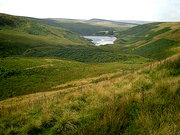Heath (habitat)
|
|
Heaths are anthropogenic habitats found primarily in northern and western Europe, where they have been created by thousands of years of human clearance of natural forest vegetation by grazing and burning on mainly infertile acidic soils. They subdivide into two broad categories depending on climate, with true heathland developing in warm, dry conditions, and moorland developing in cooler, wetter conditions. As they have developed over a long period, a unique assemblage of plants and animals has adapted to thrive in these habitats. Modern techniques of agriculture now threaten much of this habitat, by ploughing, fertilising and planting with arable crops, or conversion to commercial forestry plantations. Some are also threatened by urban sprawl.
Heathland
Heathland is a lowland habitat, and is favoured where climatic conditions are typically warm and dry, particularly in summer, and soils acidic, of low fertility, and often sandy and very free-draining; bogs do occur where drainage is poor, but are usually only small in extent. It is dominated by low shrubs, 0.2-2 m tall, particularly heather (Calluna vulgaris), heath (Erica species) and gorse (Ulex species). It is noted for the brilliant colours when these species flower in late summer (see photo, left). The habitat is maintained artificially by a combination of grazing and periodic burning, or (rarely) mowing; if not so maintained, it is rapidly re-colonised by forest, mainly of pine (Pinus species) and Silver birch (Betula pendula).
Heathlands have a very typical associated bird fauna, notably Montagu's Harrier, Eurasian Hobby, European Nightjar, Wood Lark, Tree Pipit, European Stonechat and Dartford Warbler; where there are scattered trees, Green Woodpecker is also characteristic. Some reptiles are also largely confined to healthland, notably the Sand Lizard and the Smooth Snake, and one amphibian, the Natterjack Toad. It is also an excellent habitat for ants with many species being restricted entirely to it.
One of the biggest heathlands is the Lüneburger Heide in northern Germany. Other notable heaths include large parts of the New Forest and the Breckland in southern and eastern England respectively, and the Veluwe in the Netherlands, and smaller areas in Dorset, Devon and Surrey in southern England. Heathland habitats are also found in parts of Denmark, France and Spain.
Moorland
Upland moorland habitats occur mainly in northern and western Britain and Ireland, and are similar in also often being dominated by heather, but differ from typical heathland in being colder and much wetter, often with extensive bogs, giving rise to a different mix of associated fauna, such as Red Grouse, Hen Harrier, Merlin, Golden Plover, Curlew, Sky Lark, Meadow Pipit, Whinchat, Ring Ouzel and Twite. Reptiles are fewer due to the cooler conditions, with only the Common Viper being frequent. When moorland is overgrazed by excessive numbers of sheep or deer, most of the heather is lost, being replaced by coarse, unpalatable grasses and bracken, with a greatly reduced fauna.
Notable areas of upland moorland in Britain include Bodmin Moor, Dartmoor, Exmoor, the Dark Peak, the North York Moors, the Forest of Bowland, the Lake District, the Pennines, Mid Wales, and the Southern Uplands of Scotland and the Scottish Highlands.
In more northerly latitudes, moorland is also found in lowland areas in the Scottish Highlands, Iceland and Norway; in the far north where trees do not grow naturally, moorland grades into natural tundra.da:Hede de:Heide (Landschaft) nl:Heide

